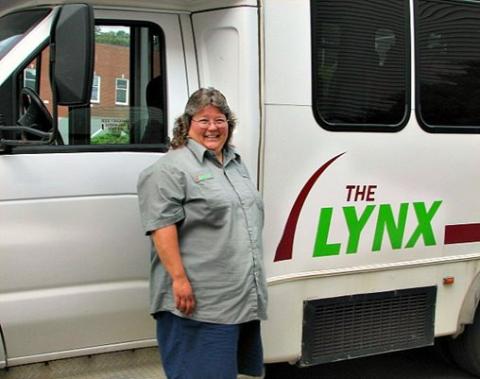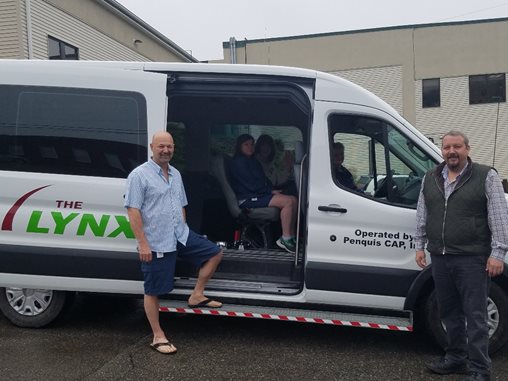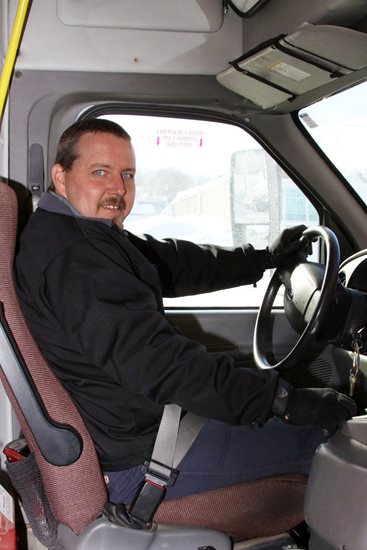Image

When most of us think about comprehensive community development, typically top of mind are affordable housing, revitalized downtowns, job creation, and partnerships to improve access to quality education and health care. But staff at Penquis, a NeighborWorks network member and community action agency in Bangor, Maine, thinks transportation should be added to the list—especially in rural areas.
“You can build the best housing, you can build the best doctors' facilities, but if people are transit-dependent and they can't get there, it won’t work,” says Marcia Larkin, director of Penquis’ Lynx Mobility Services. “People often have to travel long distances in rural areas. We serve both Penobscot and Piscataquis counties in Maine, and Piscataquis is considered one of eight frontier counties in the nation. You know, in the American culture and environment, we have to be able to jump in our cars to go get our milk or bread. We get what we need when we want it that way. But there's so many people out there that don't have that luxury. What we offer at Penquis is the only backup they have.”
Exacerbating the situation is the fact that Maine is one of the poorest states; Piscataquis County in particular is its second-lowest-income county. “We take a lot of people to food pantries and churches so they can get some healthy food,” explains Larkin. And then there is health care. Whereas small towns in the area like Greenville may have a hospital, residents must travel as far as 75 miles for chemotherapy or radiation.
The evolution of Penquis’ vital service to the community had its official start in 1994, when the primary local contractor for the Maine Department of Transportation (DOT) closed and the state asked Penquis if it could fill the gap. Prior to that time, the nonprofit had used a grant from the U.S. Department of Health and Human Services (HHS) to run a small program to get residents to medical appointments. Larkin joined Penquis at that time as one of the employees who transitioned from the shuttered former provider.
Today, what now is known as Lynx Mobility Services has attracted funding from a range of sources other than the state DOT, including HHS (for low-income families and child-welfare services), the Maine Cancer Foundation, and two other foundations—the Harold Dudley Charitable Fund of the Maine Community Foundation and John T. Gorman Foundation—that specifically fund the program to transport senior citizens.
 The outside funding ensures that many customers do not have to pay. For those who are not covered but have a disability, Penquis offers “New Freedoms,” a service funded by the Maine Department of Transportation for which only $2.50 is charged for each leg of a trip. “We keep the fee part very minimal, because even $2.50 could mean a loaf of bread or a gallon of milk for somebody,” says Larkin.
The outside funding ensures that many customers do not have to pay. For those who are not covered but have a disability, Penquis offers “New Freedoms,” a service funded by the Maine Department of Transportation for which only $2.50 is charged for each leg of a trip. “We keep the fee part very minimal, because even $2.50 could mean a loaf of bread or a gallon of milk for somebody,” says Larkin.She adds that while Penquis has funding for transporting disabled and elderly people, it is constantly looking for additional resources to transport children, a subgroup that seems to fall through the cracks.
It’s clearly a needed and popular service: From June 1, 2017, to May 31 of this year, 2,739 unique customers have been served through 82,331 trips covering 2.4 million miles. In addition, in June, Lynx was named the 2018 Outstanding Rural Transit System of the Year at the Community Transportation Association of America annual conference in Pittsburgh.
In addition to services provided by Lynx, Penquis brokered another 9.8 million miles of transportation via other services over the past year.
“On average, Penquis facilitates 13 million miles of transportation each year; that’s equivalent to traveling to the moon and back,” says Penquis CEO Kara Hay. “Increasing access to reliable transportation is a priority for Penquis because it is so critical to our region and to preserving quality of life in rural communities. Helping residents to be healthy and engaged enables communities to be vital and to prosper.”
Lessons learned
So, what are the lessons learned for other nonprofits considering getting into this line of service?Learn the rules
“First and foremost,” says Larkin, “it’s important to realize there are a lot of rules and regulations you need to follow, issued by DOT, HHS and other agencies you might contract with. So know what your compliance issues are.”
Heed the drivers
Penquis fields a corps of about 180 drivers, although Larkin says there is enough demand that they could use 300. Although the 16 “lift” vehicles for disabled passengers are driven by staff members, the other drivers are paid only by the mile. Larkin says that rate depends somewhat on the level of funding available, but it is typically 44 cents per mile, beginning when they leave their houses and ending when they return home. Each driver is expected to carry his or her own insurance, but Penquis also has an umbrella, backup policy.
“You have to make sure you do background checks because of the liability,” she notes, adding that each driver completes an extensive training curriculum originally developed by the Maine Transit Association, which includes defensive driving, cultural and disability sensitivity, first aid and customer service.
Maine can have “terrible weather” in the winter, acknowledges Larkin. Since most of the drivers are not professionals, and since vehicles are typically minivans, not heavy-duty buses, Penquis monitors the weather closely and cancels trips—except for life-dependent needs such as for dialysis—if necessary. Only what she calls the “big, brave dogs” go out on such days, to serve customers with vital needs.
 “If we know a storm may be coming, my operations manager is up at approximately 3:30 or 4 in the morning to watch developments,” says Larkin. As a result, she says the number of accidents is very low.
“If we know a storm may be coming, my operations manager is up at approximately 3:30 or 4 in the morning to watch developments,” says Larkin. As a result, she says the number of accidents is very low.In addition, Larkin adds that a sociable, outgoing personality is important, since drivers are the only people customers may see in a day, or even a week.
“You know, everybody's pushing the trend toward driverless cars and all of that and I think for some people that will be really cool,” says Larkin. “But that being said, our vehicle operators, know a lot of our customers. They know if something isn't right. So, the interaction between volunteer drivers and customers is significant.”
Perhaps the best way to explain the value of the service offered by Lynx is with a story of one of its regular users, Bill (who asked that his last name not be used):
Bill is a veteran and served in the Navy, spending four years overseas. He is now 80 years old and a resident of rural Maine. Bill still has his driver’s license but two years ago was in a bad car accident. He lost control of his vehicle on a winter evening and his car went down a bank and into a brook. Luckily, the local sheriff was about 5 minutes away. After finding Bill, the sheriff called for an ambulance and fire trucks, and the crews were able to safely extract Bill from his car. Since that evening, he has chosen not to drive.
Unfortunately, Bill also has significant health challenges and needs help getting to regular appointments at the local Veterans Affairs hospital, almost 100 miles away. That’s a 1-hour-and-50-minute drive. That’s where Penquis Lynx Mobility Services comes in. He also uses Lynx for transportation around town to do errands, such as grocery shopping and banking. Bill’s only complaint is having to give advance notice to get a ride. There are times when he has to decline medical appointments that come up unexpectedly, because Lynx is already booked for that day.
Bill compliments the drivers for keeping him safe. “I watch that speedometer, and if it says 55 miles per hour, they do 55 miles per hour. More people need to know about this service. I know of veterans who just can’t get to places and I want to help spread the word.”

